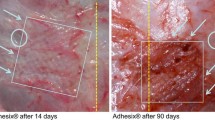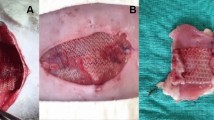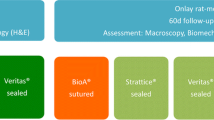Abstract
Purpose
To compare adhesion scores, repair strength and histological findings among sublay, onlay and primary repair incisional hernioplasty techniques. Surgical repairs were employed directly on healthy animals, without previous hernia induction, to avoid confounding factors related to hernia development.
Methods
Forty Wistar rats were divided into four groups, control, simulation, onlay and sublay. After 42 days, adhesion intensity, tensile strength of the abdominal wall and anatomopathological histological substrate were compared.
Results
SL group presented greater adhesion scores (p < 0.0001), higher tensiometric (p < 0.0001), and was characterized by more histiocytes, mononuclear cells, macrovacuolar granulomas and type I collagen on histological analysis. Pearson correlation between adhesions and tensiometry, and between tensiometry and neocollagenization showed a strong positive association (r = 0.8905 and 0.6757, respectively in SL group, p < 0.05).
Conclusion
Mesh positioning in sublay compartment was followed by increased adhesion development and provides a stronger mesh–tissue attachment, in addition, resulted in a different histological profile of the inflammation/repair substrate. The intensity of these findings was directly correlated, suggesting they could be the result of a common biological phenomenon. Our findings indicate that mesh placement following the retromuscular technique generates a superior repair response, and give clues to a better understanding of the superiority of sublay repair in achieving lower recurrence rates. Characterization of the cellular and molecular elements responsible for the superiority of this technique is in our view an essential prerequisite aiming for improvements in the therapeutic options for the treatment of this disease.






Similar content being viewed by others
References
Millikan KW (2003) Incisional hernia repair. Surg Clin N Am 83:1223–1234
den Hartog D, Dur AH, Tuinebreijer WE, Kreis RW (2008) Open surgical procedures for incisional hernias. Cochrane Database Syst Rev 3:CD006438
Luijendijk RW, Hop WCJ, van den Tol P, de Lange DCD, Braaksma MMJ, Ijzermans JNM, Boelhouwer RU, de Vries BC, Salu MKM, Wereldsma JCJ, Bruijninckx CMA, Jeekel J (2010) A comparison of suture repair with mesh repair for incisional hernia. N Engl J Med 343(6):392–398
Burger JW, Luijendijk RW, Hop WC, Halm J, Verdaasdonk EG, Jeekel J (2004) Long-term follow-up of a randomized controlled trial of suture versus mesh repair of incisional hernia. Ann Surg 240(4):578–583
Biondo-Simões MLP, Morais CF, Tocchio AFZ, Miranda RA, Moura PAP, Colla K, Robes RR, Ioshii SO, Tomasich FDS (2016) Characteristics of the fibroplasia and collagen expression in the abdominal wall after implant of the polypropylene mesh and polypropylene/polyglecaprone mesh in rats. Acta Cir Bras 31:294–299
Nursal TZ, Hamalogku E (1999) Insizyonel herniler. T Klin Cerrahi 4:182–187
Batkir A, Dogru O, Girgin M, Aygen E, Kanat BH, Dabak DO, Kuloglu T (2013) The effects of different prosthetic materials on the formation of collagen types in incisional hernia. Hernia 17:249–253
Albino F, Patel K, Nahabedian M, Sosin M, Attinger C, Bhanot P (2013) Does mesh location matter in abdominal wall reconstruction. A systematic review of the literature and a summary of recommendations. Plast Reconstr Surg 132(5):1295–1304
Hawn M, Snyder C, Graham L, Gray S, Finan K, Vick C (2010) Long-term follow up of technical outcomes for incisional hernia repair. J Am Coll Surg 210(5):648–655
Holihan JL, Nguyen DH, Nguyen MT, Mo J, Kao LS, Liang MK (2016) Mesh location in open ventral hernia repair: a systematic review and network meta-analysis. World J Surg 40:89
Chevrel JP (1979) The treatment of large midline incisional hernias by “overcoat” platy and prothesis (author’s transl). Nouv Presse Med 8(9):695–696
Rivers J, Lardennois B, Pire JC, Hibon J (1973) Large incisional hernias. The importance of flail abdomen and of subsequent respiratory disorders. Chirurgie 99(8):547–563
Neligan P, Peter C (2015) Plastic surgery: principles, 3rd edn. Elsevier, Rio de Janeiro, pp 240–252
Ricciardi BF, Chequim LH, Gama RR, Hassegawa L (2012) Correction of abdominal hernia with mesh surrounded by fibrous tissue—study in Wistar rats. Rev Col Bras Cir 39(3):195–200
Jairam AP, Timmermans L, Eker HH, Pierik R, van Klaveren D, Steyerberg EW et al (2017) Prevention of incisional hernia with prophylactic onlay and sublay mesh reinforcement versus primary suture only in midline laparotomies (PRIMA): 2-year follow-up of a multicentre, double-blind, randomised controlled trial. Lancet 390(10094):567–576
Serigiolle LC, Barbieri RL, Gomes HMP, Rodrigues DAB, Studart SV, Leme PLS (2015) Critical analysis of experimental models for the study of adherences after induced incisional hernias in rats and abdominal wall repair with different biomaterials. Arq Bras Cir Dig 28(3):178–182
Klosterhafen B, Junge K, Hermanns B, Klinge U (2002) Influence of implantation interval on the long-term biocompatibility of surgical mesh. Br J Surg 89:1043–1048
Morris-stiff GJ, Hughes LE (1998) The outcomes of nonabsorbable mesh placed within the abdominal cavity: literature review and clinical experience. J Am Coll Surg 186:352–367
van’t Riet M, Burger JW, Bonthuis F, Jeekel J, Bonjer JH (2004) Prevention of adhesion formation to polypropylene mesh by collagen coating. A randomized controlled study in a rat model of ventral hernia repair. Surg Endosc 18:681–685
Sergent F, Desilles N, Lacoume Y, Tuech J, Marie J, Bunel C (2010) Biomechanical analysis of polypropylene prosthetic implants for hernia repair: an experimental study. Am J Surg 200:406–412
Schonleben F, Reck T, Tannapfel A, Hohenberger W, Schneider I (2006) Collagen foil (TissuFoil E) reduces the formation of adhesions when using polypropylene mesh for the repair of experimental abdominal wall defects. Int J Colorectal Dis 21:840–846
Utiyama E, Rosa M, Andres M, Miranda J, Damous S, Birolini C, Damous L, Montero E (2015) Polypropylene and polypropylene/polyglecaprone (Ultrapro®) meshes in the repair of incisional hernias in rats. Acta Cir Bras 30(6):379–381
Voskerician G, Jin J, Hunter S, Williams C, White M, Rosen M (2009) Human peritoneal membrane reduces the formation of intra-abdominal adhesions in ventral hernia repair: experimental study in a chronic hernia rat model. J Surg Res 157:108–114
Akinci M, Ergul Z, Kantarcioglu M, Tapan S, Ozier M, Gunal A, Kulacoglu H, Ide T, Sayal A, Eryilmaz M, Kozak O (2014) The effect of relaparotomy timing on wound healing in an animal model. Int J Surg 12:1434–1438
Utrabo C, Czeczko N, Busato C, Montemór-Netto M, Lipinski L, Malafaia (2017) Tensiometric analysis of meshes used in abdominal ventral wall defects in rats. Arq Bras Cir Dig 30(3):165–168
Höer J, Töns Ch, Schachtrupp A, Anurov M, Titkova S, Oettinger A, Schumpelick S (2002) Quantitative evaluation of abdominal wall perfusion after different types of laparotomy closure using laser fluorescence videography. Hernia 6:11–16
Schachtrupp A, Wetter O, Höer J (2016) An implantable sensor device measuring suture tension dynamics: results of developmental and experimental work. Hernia 20:601–606
Altman A, Khalek F, Alt E, Butler C (2010) Adipose tissue-derived stem cells enhance bioprosthetic mesh repair in ventral hernias. Plast Reconstr Surg 126(3):845–854
Maeda CT, Artigani Neto R, Lopes-Filho GJ, Linhares MM (2016) Experimental study of inflammatory response and collagen morphometry with different types of meshes. Hernia 20:859–867
Binnebösel M, Klink CD, Otto J, Conze J, Jansen PL, Anurov M, Schumpelik V, Junge K (2010) Impact of mesh positioning on foreign body reaction and collagenous ingrowth in a rabbit model of open incisional hernia repair. Hernia 14:71–77
Author information
Authors and Affiliations
Ethics declarations
Conflict of interest
The authors declare that they have no conflict of interest in this research.
Ethical approval
The authors declare that that the ethical standards were obeyed, beginning their work and research after approval of the Ethics Committee for the Use of Animals in Scientific Experimentation of the Health Sciences Center of the Universidade Federal do Rio de Janeiro (CEUA-CCS), registered in the National Council for the Control of Animal Experimentation (CONCEA) under process number 01200.001568/2013-87.
Human and animal rights
All procedures performed in studies involving animals were in accordance with the ethical standards of the institution or practice at which the studies were conducted.
Informed consent
For this type of study, formal consent is not required.
Rights and permissions
About this article
Cite this article
Ponce Leon, F., Manso, J.E.F., Abud, V.L. et al. Sublay repair results in superior mesh incorporation and histological fibrogenesis in comparison to onlay and primary suture in an experimental rat model. Hernia 22, 1089–1100 (2018). https://doi.org/10.1007/s10029-018-1808-y
Received:
Accepted:
Published:
Issue Date:
DOI: https://doi.org/10.1007/s10029-018-1808-y




